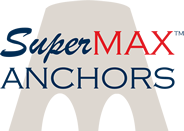The importance of matching all components of a vessel’s ground tackle can not be overlooked. Anchor companies sell anchors based on a vessels weight or length. As a cost saving measure, anchor companies recommend an anchor that is at the lower end of a vessel’s length. They convince the boat owner that their anchor, at a lesser price is, “all you need”. Some recommend an anchor based on the vessels weight. Of the two factors, gross tonnage is more important to consider when weather conditions turn bad and wind, current, and waves place all that tonnage against the set anchor and ground tackle. Anchors are also typically matched to a vessel based on anchoring in “ideal” conditions: under 30 knot winds, in a firm holding sea bed, and with great protection from wind sheer and waves. Almost any anchor will work in ideal conditions because there is little or no stress on the anchor or ground tackle.
How many of us only encounter ideal anchoring conditions? If you anchor a lot, your ground tackle will be challenged by wind, waves, currents or dangerous weather. A $100-$200 savings on a minimal holding anchor does not seem like a good investment if you drag anchor and strike another vessel or structure. A vessel should have an anchor that is:
- based on the gross tonnage of your boat rather than length,
- holds in less than ideal holding sea beds
- designed to hold secure in more adverse weather conditions
Along with an anchor that maximizes a vessels holding in a variety of sea beds and adverse weather conditions, make sure your ground tackle matches the holding power of the new anchor by;
- Considering the size, strength, and type of the chain
- Assuring anchor shackles, chain shackles, and swivels (if you decide to use a swivel in your ground tackle arrangement) are manufactured by a “reputable” company for confidence in their advertised strength.
Many companies, national and international, make shackles and swivels. They are inexpensive items but one should not overlook their quality and strength. Size your ground tackle based upon “working load” and not breaking point load. A component functioning within the working load level limits should not distort, bend, or break. If a component becomes compromised, it is weakened and may fail with varying pressures.
When matching an anchor and the components of ground tackle, you do not want one component to be the definite “weak link” in the arrangement. What good is a chain with 3900 lbs working load and an anchor with 4000 lbs holding power if the $15 shackle is rated at 1000 lbs? That small item could end up costing you tens of thousands of dollars. If it fails, the great anchor is on the bottom, your chain is dangling from the bow roller, and your boat is on the hard. Take the time to investigate and make sure all the ground tackle from anchor to rope rode is sized appropriately.
If you need assistance in matching your Super MAX Anchor with appropriate ground tackle components, Max Marine Products is your source.
